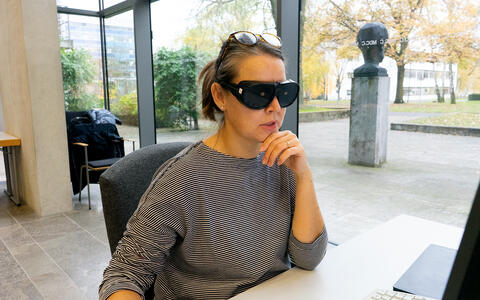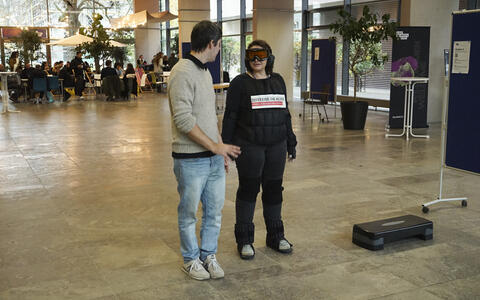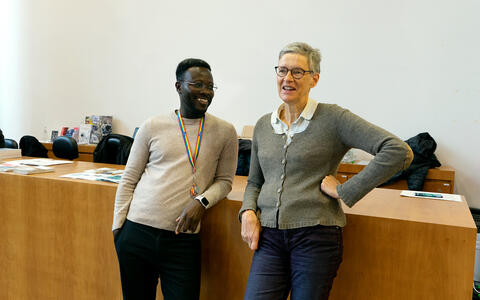Driving conversations on diversity
This year, Diversity Week at the Max Delbrück Center offered a range of activities for the whole community. One particular highlight was an experiential workshop, centered on the topic of disabilities. Members of our community could experience barriers caused by obvious or impairment. At Campus Buch, participants were invited to explore different stations that were equipped with devices to impart a deeper understanding of what it feels like to live and work with major physical disabilities.
At the visual impairment stations, participants could don glasses that simulate varying degrees of blindness, and were asked to type on a computer and to operate a lab microscope. The remainder of the stations were dedicated to simulating limited mobility, whether by using wheelchairs, crutches or an “age simulation suit.”
This suit consisted of a collection of attachable body weights on the ankles, wrists and shoulders, with elbow and knee restrictors to limit joint movement. Participants completed a series of physical tasks such as climbing stairs, sitting up and down, and lifting objects off the floor. The exercises were intended to simulate the physical challenges experienced by people above the age of 80, and enabled them to better understand the difficulty of movement that many elderly people experience as they age.
Overseen by Marion Posselt-Hofmann, a representative for severely disabled people and who promotes the inclusion of employees with disabilities on campus, participants were then asked a series of questions: What barriers became apparent to you during these exercises? What sort of emotions did you experience? How safe did you feel conducting these activities? “I hope that the simulations will spark more conversation about barrier free work environments and the ways in which we can make our institute more accessible to all,” she says. “It is important to minimize the fear of engaging with the topic of disability and inclusion. It acts as a barrier in people's minds and is just as much of a hindrance as physical barriers,” she adds.
Inclusion fosters innovation
During a community talk later in the week, Professor Isabell Welpe discussed how diverse and inclusive environments foster innovation, leadership’s role and best practices.
A work culture that does not change is one of the greatest inhibitors to company expansion and potential growth, she said. The seven most expensive words for any organization are “we have always done it like this.” Organizations that do not change run the risk of becoming irrelevant.
One major driver of change is diversity. There is a positive correlation between diversity and innovation, Welpe explained, particularly in terms of diversity of background, country of origin, career path and gender. The ideal type of diversity for innovation requires complementary knowledge and similar values in an organization. These factors play a significantly larger role in company performance in comparison to characteristics such as age and academic background.
How can employers foster more diversity to ensure change? Organizations should offer incentives to encourage staff to implement Diversity Equity and Inclusion initiatives (DEI), she said. They should also adapt specific hiring measures to ensure a diverse workforce, such as including an element of chance in the selection process, for example, to avoid unconscious bias, and recruiting broadly.
Moreover, though many different leadership styles exist, Welpe emphasized that mutual trust and fairness are the common threads necessary for teams to perform at a high level. Leaders should establish an inclusive culture so that team members feel that they belong and gain trust in the actions of the leader. Including everyone in the process will ensure a diversity of opinions. Welpe quoted Charles Darwin who said “It's not the strongest who survive, but those who adapt,” adding that the same can be said of organizations.
How to be an Active Bystander
Participants in the Active Bystander workshop learned how to address unacceptable behaviors with confidence. They were taught skills necessary to react constructively when witnessing inappropriate behavior in the workplace.
Amanda Gardiner, a facilitator of Active Bystander initiatives who led the online workshop, stressed that the key to being an active bystander starts with noticing an event, considering it a problem, and possessing the skills required to take responsibility. No matter what the situation, she encouraged the participants to use one of “the Four D’s,” since we are all responsible for improving our work culture.
She presented the “the Four D's” as a manual with distinct strategies for intervention: Direct Action, Distraction, Delegation and Delay. Direct Action means reacting immediately to problematic situations. It can take the form of calling out the event or perpetrator and explaining why it is unacceptable, publicly supporting the target of a situation, or encouraging dialogue to diffuse a situation. Distraction, on the other hand, involves an indirect intervention to de-escalate the situation, either by interrupting, changing the subject, or taking the target away from the situation. Delegation entails seeking out immediate support. Delay prioritizes seeking support after a situation has already happened. According to Gardiner, each of these strategies can help create a safer and more respectful work environment.
Inclusion is part of our mission
The Max Delbrück Center has recently published its Strategy 2030 that includes strengthening the community and improving workplace culture as a whole as one of its primary aims. “Fostering a diverse and inclusive environment is a collective responsibility,” says Dr. Jean-Yves Tano from the People and Culture department and who organized Diversity Week. “This event plays a vital role in promoting a culture where respect and safety are paramount. Our staff is the foundation of our success. It’s crucial that we work together to ensure a workplace free from harassment and discrimination.”
Sessions during this year’s Diversity Week event discussed introversion vs. extraversion, resilience, innovation, science communication, caregiving, and more. “Our community members are urged to explore these themes further via our e-learnings and to foster enhanced communication and mutual understanding.”
Text: Olivia Noss









